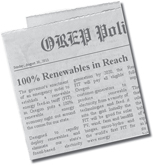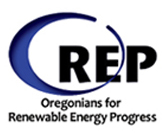OREP Testimony for Utility Advice Filings for Oregon's Solar Pilot Programs
before the public utiLity commission
of Oregon
AR 538 and UM 1452
In the Matter of ) COMMENTS OF
) OREGONIANS FOR RENEWABLE ENERGY POLICY
PUBLIC UTILITY COMMISSION ) REGARDING UTILITY ADVICE FILINGS FOR ORDERS 10-198 AND 10-200
OF OREGON )
)
Investigation into Pilot Programs to )
Demonstrate the Use and )
Effectiveness of Volumetric )
Incentive Rates for Solar )
Photovoltaic Energy Systems )
Oregonians for Renewable Energy Policy (“OREP”) submits the following comments regarding the advice filings submitted by Portland General Electric, Pacific Power and Idaho Power in compliance with PUC Orders 10-198 and 10-200 for Oregon’s Solar Pilot Programs. On reviewing the above filings, OREP finds the following sections to be of concern as they appear inconsistent with the language or the spirit of AR 538 and/or UM 1452 and because of the problems we believe they will create in implementing the pilot program. We suggest appropriate remedies as follows.
Issue 1. Payments Options
THE RULE/ORDER STATES:AR 538 -860-084-250 (PAGE 12) states:
"We revise the rule to read as follows:
(1) Volumetric incentive payments for payable energy must be paid no later than 45 days from the last day of the retail electricity consumer's billing period. Retail electricity consumers may request that:(a) Payments be paid directly to the consumer; the consumer will continue to receive a standard monthly bill for electricity purchased under the tariff; or
(b) Payments for energy generated be netted against the retail electricity consumer's standard monthly bill and the retail electricity consumer receive or pay the resulting amount; or
(c) The qualified assignee identified on the standard contract be paid 100 percent of the volumetric incentive rate payment and the retail electricity consumer be billed separately for the retail electricity consumer's monthly bill."
INCONSISTENCY:
Portland General Electric, in Advice Filing 10-13, Original Sheet 205-3, under VIR Payments states: "The VIR payment will be reduced by the amount of the retail bill offset for a net VIR payment".
Pacific Power, in Advice Filing 10-012, under Section 5: Volumetric Incentive Rates, states: "Pacific Power shall pay the Participant the difference between Participant’s Volumetric Incentive Rate ... and Participant’s Retail Rate ... for all Payable Generation."
Idaho Power, in Advice Filing 10-11, in Original Sheet 88-4, under "Volumetric Incentive Payment" restates the three utility consumer generator choices from AR538 -860-084-250. It then defines "Monthly Rate" as "...the net of the Meter Charge and the Volumetric Incentive Payment".
All three utilities appear to be netting the consumer's generation against the monthly bill before making any payment for payable generation. This will satisfy consumers who select payment option (b). However, none of the utilities describe a plan to make options (a), in which the consumer receives a payment for payable generation separate from their monthly bill, or (c), in which a third party assignee receives a payment for 100 percent of payable generation and the consumer generator is billed separately for their usage.
PROBLEM CREATED:
During rulemaking, payment options (a) and (c) were created in order to make it easier for consumer generators to obtain third party financing from investors. Potential investors looking at this program are already getting cold feet once they realize that although they are designated as the assignee, they will not receive 100% of the payments for generation made over to them but will have to collect a portion of their repayment directly from the consumer generator, who will receive some compensation in the form of a lowered monthly bill.
SOLUTION:
Revise Portland General Electric, Pacific Power and Idaho Power advice filings to make provision for consumer generators to access payment options (a) and (c) in AR538 -860-084-250, so that they or their assignee may receive 100% of payments for payable generation directly.
Issue 2. Utility Participation as Qualified Assignee
THE RULE/ORDER STATES:
In PUC Order 10-200 (AR 538) in the final paragraph at the bottom of page three, the Commission states "Pacific Power and Idaho Power next propose revisions to accommodate an electric company to participate in the pilot programs. These proposed changes include adding new definitions for 'participant', and revisions to the definitions for 'eligible participant', 'qualifying assignee', and 'assignee'. Because we conclude in UM 1452 that electric companies are not eligible to participate in the pilot programs, we decline to adopt these proposed definitional changes."
INCONSISTENCY:
Pacific Power, in Advice Filing 10-012, in Section 1: Definitions, subsection 1.18 states that: " 'Qualifying Assignee’ means a person to whom Participant may assign Volumetric incentive payments. Pacific Power or its affiliate or any other regulated utility is not a Qualifying Assignee, unless otherwise specified by Participant..." (italics added).
PROBLEM CREATED:
Pacific Power, unlike Portland General Electric or Idaho Power, has added this exception to the stated rule that regulated utilities may not be assignees, by permitting a Participant to designate them as a Qualified Assignee. Allowing utilities to participate in the pilot will distort the value of the data the pilot will collect as we try to learn how non-utilities are motivated to produce solar electricity. Because utilities can recover their costs they have considerably less risk than other types of participants. What we are trying to learn with the pilot is what producers with money at risk will need in order to invest.
SOLUTION:
Revise Pacific Power's Advice Fling 10-012 to delete the phrase "... unless otherwise specified by Participant...” in subsection 1.18 under the definition of Qualifying Assignee.
Issue 3. Liability insurance coverage period
THE RULE/ORDER STATES:
In PUC Order, 10-200, page 13, item O. Insurance, the Commission states: "We find that the cost of insurance is reasonably incurred by a consumer, and have included insurance costs in the derivation of the cost-based rate for small-scale and medium-scale systems. We revise the rule to read as follows: OAR 860-084-0300 A contracted system must obtain liability insurance in order to interconnect with the electric company's distribution system." While insurance rates were included in the derivation of rates, these costs were only assumed to cover the 15 years of the contract.
INCONSISTENCY:
Pacific Power, in Advice Filing 10-012, in Section 15: Insurance, under 15.5 states that: "Insurance coverage provided on a "claims-made" basis shall be maintained by the Participant for a minimum period of five (5) years after the completion of this Agreement and for such other length of time necessary to cover liabilities arising out of the activities under this Agreement." The Rule/Order does not require such extended coverage, nor was it included in PUC's rate calculation.
PROBLEM CREATED:
This additional coverage was not included in PUC's rate calculation and creates an additional ongoing cost for consumer generators that extends beyond the life of the contract. Since neither Portland General Electric nor Idaho Power require such extended coverage, this additional cost will only be borne by consumer generators in Pacific Power's territory and will put them at a disadvantage in participating in the pilot program. Insurance needs to be kept over the life of the contract and not beyond. Insurance requirements should be consistent among all the utilities.
SOLUTION:
Revise Pacific Power's Advice Fling 10-012 to delete Section 15.5 from their contract.
Issue 4. Sizing systems to 90% of recent usage.
THE RULE/ORDER STATES:
OAR 860-084-0240 Standard Contracts Section (2) (m) requires that net-metered participants certify their system is sized in compliance with 860-084-0100 (2) (e), which requires systems to be sized so as to provide an estimated generation equal to 90 percent of the rolling average usage at the premises where the system is installed. This section also provides that "If this average cannot be determined, the nameplate capacity can be no more than 90 percent of a rolling average of three year's usage by a similarly-situated customer, as determined by the electric company” .(italics added).
INCONSISTENCY:
None of the Advice Filings submitted contain any guidance on how to determine the rolling average of a similarly-situated customer, in cases where the consumer cannot determine it for himself or herself.
PROBLEM CREATED:
Those who do not keep records of their past utility bills, or who are new customers, will have difficulty determining what size system to install in order to ensure cost recovery from the VIR payments. Guidance from the utilities was clearly anticipated by the Rule, but when asked by the public if such guidance would be provided, Portland General Electric and Pacific Power said they were not planning to provide this.
SOLUTION:
Revise Advice Filings submitted by Portland General Electric, Pacific Power and Idaho Power to include a table of average consumer usage by customer categories to assist consumer generators who cannot determine the rolling average for their last three years of average usage.
DATED this 27th day of June 2010.
OREGONIANS FOR RENEWABLE ENERGY POLICY
/s /Judith K. Barnes


